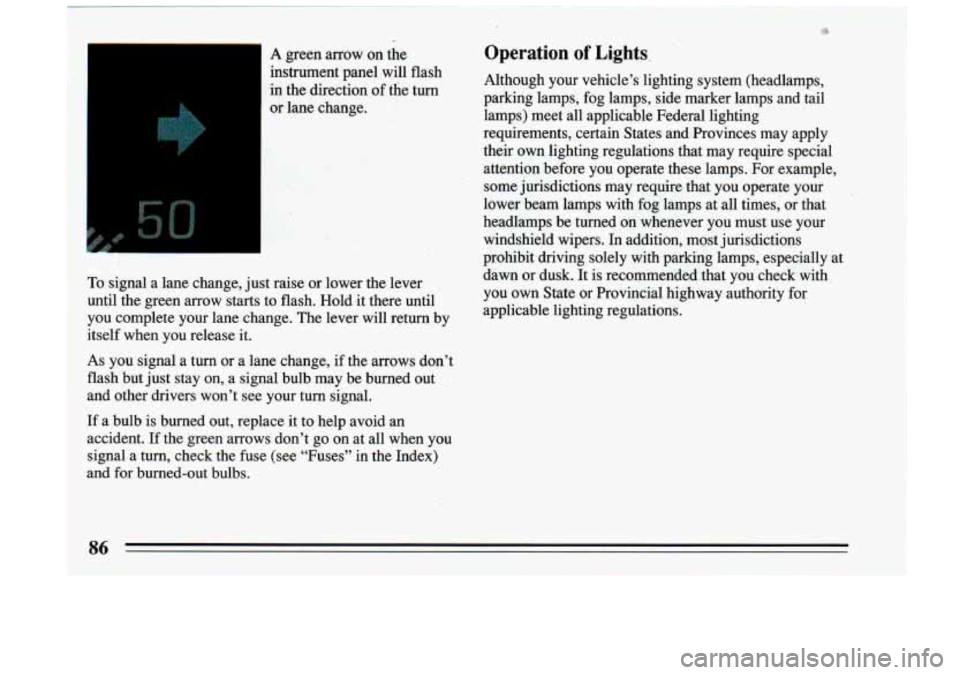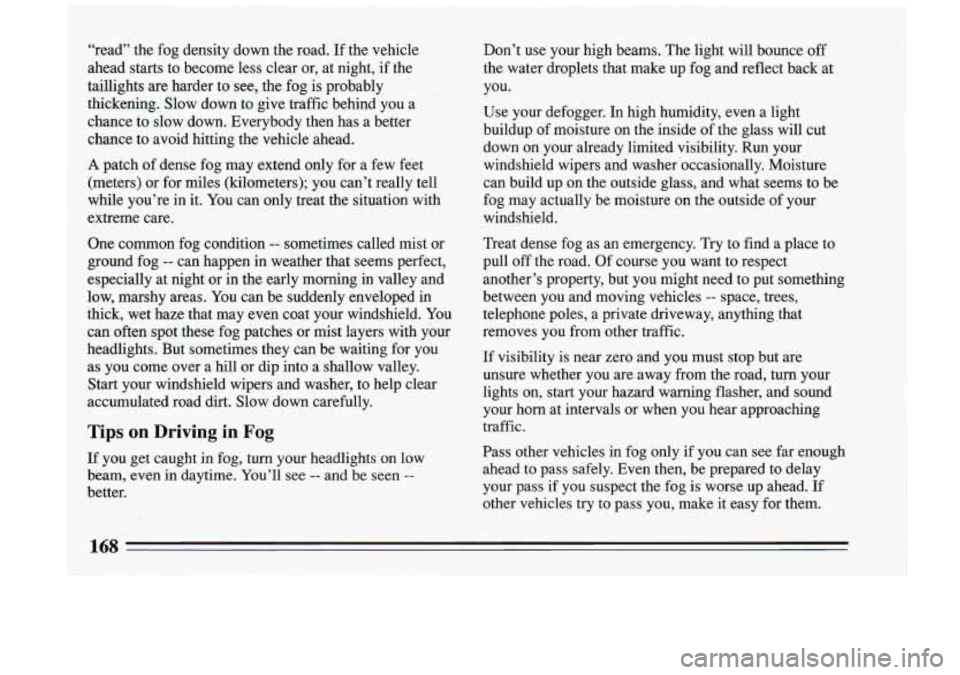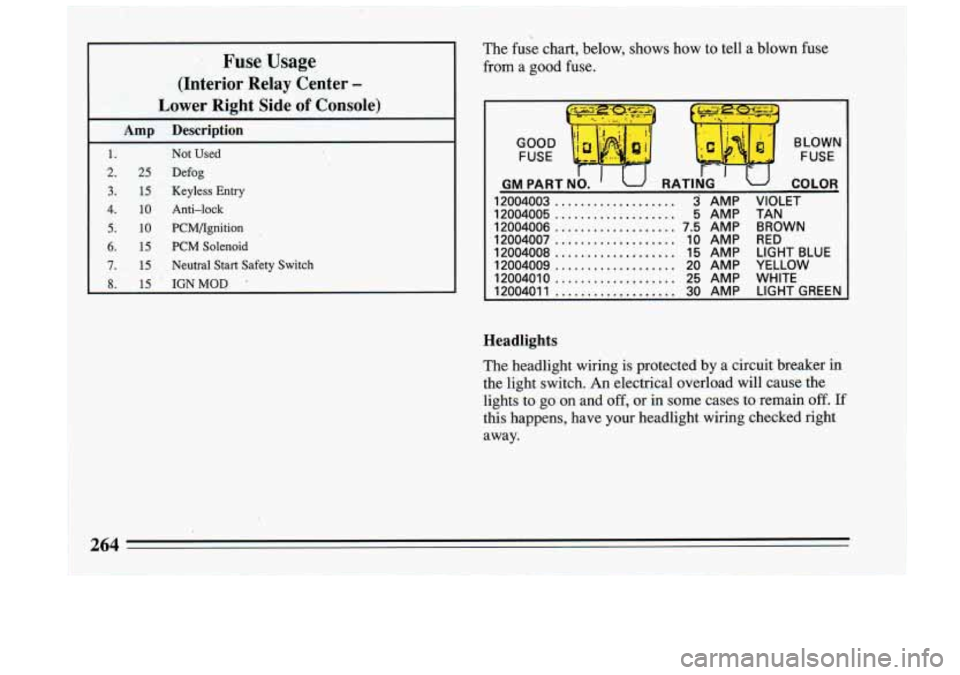fog light BUICK RIVIERA 1993 Owners Manual
[x] Cancel search | Manufacturer: BUICK, Model Year: 1993, Model line: RIVIERA, Model: BUICK RIVIERA 1993Pages: 324, PDF Size: 16.01 MB
Page 14 of 324

Vehicle Symbols
These are some of the symbols you will find on your vehicle.
For example,
these symbols
are used on an
original battery:
POSSIBLE A
CAUTION
INJURY
PROTECT EYES BY
SHIELDING
CAUSTIC
BURNS AVOID
SPARKS
OR
FLAMES
SPARK
OR ,111,
COULD pq
FLAME
EXPLODE BATTERY
These symbols
are important
for you and
your passengers whenever your
vehicle
is
driven:
FASTEN SEAT 4
BELTS
These symbols
have to do with
your lights:
SIGNALS TURN
HIGH BEAM
OR = =o
FOG LAMPS $0
These symbols
are on some
of
your controls:
WINDSHIELD ’ ’ ’ 4- #-
WASHER
f0 -**
WINDSHIELD Q
WASHER I
WINDSHIELD
DEFROSTER
WINDOW
DEFOGGER
VENTILATING
FAN
L.
HEADLAMP - ,~*-,
WASHER iQ
WIPER -
L
These symbols
are used on
warning and
indicator lights:
COOLANT F-
TEMP --
ENGINE
CHARGING
I-1
BATTERY SYSTEM
RADIATOR
a
COOLANT
FUEL
ENGINE OIL
PRESSURE
Wb
TEMP OIL &
ANTILOCK (@)
BRAKE
Here are some
other symbols
you may see:
FUSE
RADIO
‘‘ill
SELECTOR
RADIO
k
VOLUME
CONDITIONING
AIR 33
HATCHBACK /y
TRUNK
RELEASE
t LIGHTER 1-
HORN
SPEAKER
cr
~ 12 , .
Page 88 of 324

L
in the direciion of the turn
or lane change.
To signal a lane change, just raise or lower
the lever
until the green arrow starts to flash. Hold it there until
you complete your lane change. The lever will return by
itself when you release it.
As you signal a turn or a lane change, if the arrows don’t
flash but just stay on, a signal bulb may be burned out
‘and other drivers won’t see your turn signal.
Operation of Lights.
Although your vehicle’s lighting system (headlamps,
parking lamps, fog lamps, side marker lamps and tail
lamps) meet all applicable Federal lighting
requirements, certain States and Rovinces may apply
their
own lighting regulations that may require special
attention before you operate these lamps. For example,
some jurisdictions may require that you operate your
lower beam lamps with fog lamps at all times, or that
headlamps be turned on whenever you must use your
windshield wipers. In addition, most jurisdictions
prohibit driving solely with parking lamps, especially at
dawn or dusk. It is recommended that you check with you own State or Provincial highway authority
for
applicable lighting regulations.
1
If a bulb is burned out, replace it to help avoid an
accident.
If the green arrows don’t go on at all when you
signal a turn, check the fuse (see “Fuses” in the Index)
hnd-fQr bumed-Qvt bulbs. i
3
Page 169 of 324

if the pressure in one or more is low. It can happen if a
lot of water
is standing on the road. If you can see
reflections from trees, telephone poles, or other vehicles, and raindrops “dimple” the water’s surface, there could \
be hydroplaning.
Hydroplaning usually happens at higher speeds. There
just isn’t a hard and fast rule about hydroplaning. The
best advice is to slow down when it is raining, and be
.
careful.
Some Other .Rainy Weather Tips
0
0
0
0
0
Turn on your headlights -- not just your parking
lights
-- to help make you more visible to others.
Look for hard-to-see vehicles corning from behind.
You may want to use your headlights even in
daytime if it’s raining hard.
Besides slowing down, allow some extra following
distance. And be especially careful when you pass
another vehicle. Allow yourself more clear room
ahead, and be prepared to have your view restricted
by road spray. If the road spray is
so heavy you are
actually blinded, drop back. Don’t pass until conditions improve. Going more slowly
is better
than having an accident.
Use your defogger
if it helps.
Have good tires with proper tread depth. (See
“Tires” in the Index.)
Driving in Fog, Mist and Haze
IIII
Fog can occur with high humidity or heavy frost. It can,
be
so mild that you can see through it for several
hundred feet (meters).
Or it might be so thick that you
can see only a few feet (meters) ahead. It may come
suddenly to an otherwise clear road. And it can be a
major hazard.
When you drive into a fog patch, your visibility will be
reduced quickly. The biggest dangers are striking the
vehicle ahead
or being struck by the one behind. Try to
167
Page 170 of 324

Don’t use your high beams. The light will bounce off
the water droplets that make up fog and reflect back at
you.
Use your defogger.
In high humidity, even a light
buildup of moisture on the inside of the glass will cut
down on your already limited visibility.
Run your
windshield wipers and washer ‘occasionally. Moisture
can build up on the outside glass, and what seems to be
fog may actually be moisture on the outside of your
windshield.
Treat dense fog as an emergency.
Try to find a place to
pull off the road. Of course you want to respect
another’s property, but you might need to put something
between you and moving vehicles
-- space, trees,
telephone poles, a private driveway, anything ,that
removes you from other traffic.
If visibility is near zero and you
must stop but are
unsure whether you are away from the road, tu_m your
lights on, start your hazard warning flasher, and sound your horn at intervals or when you hear approaching
traffic.
Pass other vehicles in fog only if you can see far enough
ahead to pass safely. Even then, be prepared to delay
your pass if you suspect the fog is worse up ahead.
If
other vehicles try to pass you, make it easy for them.
Page 266 of 324

i
Fuse Usage
(Interior Relay Center -
Lower Right Side of Console)
Amp Description
1. Not Used
2. 25 Defog
3. 15 Keyless Entry
4. 10 Anti-lock
5. 10 PCMflgnition
6. 15 PCM Solenoid
7. 15 Neutral Start Safety Switch
8. 15 ' IGN MOD -
The fuse chart, below, shows how to tell a blown fuse
from a good fuse.
GOOD
FUSE '
rll
-1
I
BLOWN
FUSE
GM PARTNO. ' U RATING ' U COLO~
12004003
................... 3 AMP VIOLET
'12004005
................... 5 AMP TAN
12004006
................... 7.5 AMP BROWN
12004007
................... 10 AMP RED
12004008
.................... 15 AMP LIGHT BLUE
12004009
................... 20 AMP
YELLOW
12004010
................... 25 AMP WHITE
120040.1 1
................... 30 AMP LIGHT GREEN
Headlights
The headlight wiring is protected by a circuit breaker in
the light switch.
An electrical overload will cause the
lights to go on and
off, or in some cases to remain off. If
this happens, have your headlight wiring checked right away.